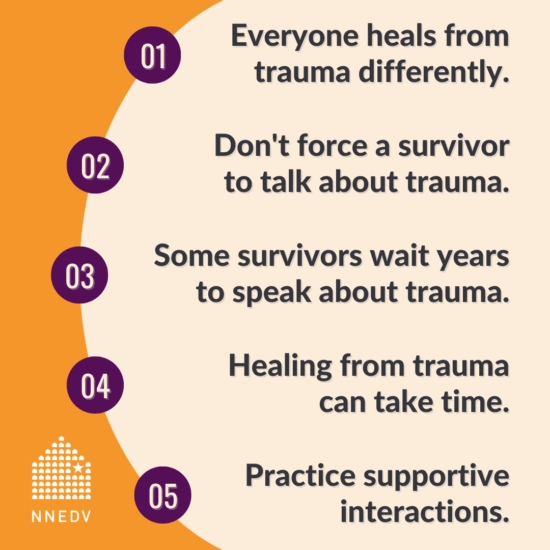Understanding the Importance of Trauma-Informed Care
When we hear the word “trauma,” most of us have an instinctive understanding of what it means: the severe distress, harm, or suffering that results from overwhelming mental or emotional pain or physical injury.
It is no secret that survivors of domestic violence need time to feel safe again even after the danger of abuse is gone. However, meeting the needs of trauma survivors takes a great deal of sensitivity. Trauma-informed care starts with asking the right questions: moving from “What is wrong with you?” to “What happened to you?” and “How has this experience affected you?”
Individualized care is a must. After all, what is traumatic for one person may not be for another, and each person follows their own path to healing. The question then becomes: “How do you perceive what happened to you?” or “Where are you in your healing process?”
No matter what type of abuse someone has lived through, research shows that the resulting trauma can have long-term effects on the body. Headaches, joint pain, difficulty sleeping, and gastrointestinal, respiratory, and cardiovascular issues may occur.
Trauma-informed care recognizes how trauma affects the brain. Hyperactivity in the lower areas of the brain – the amygdala and hippocampus – overrides the prefrontal cortex, which is in charge of rational choices and modulating emotional responses. This keeps a person in survival mode, even after the danger has passed. Memories can also be stored in the wrong place, keeping difficult memories active.
Post-Traumatic Stress Disorder (PTSD) is a specific set of symptoms that some trauma survivors develop. According to the National Institute for Mental Health, people with PTSD relive the traumatic event, avoid situations that remind them of the past, and have negative thoughts about themselves or the world. They also experience hyper-arousal (being anxious and on the lookout for danger, having trouble sleeping, or getting angry or irritable).
Trauma-informed care takes into account the physical and mental effects of trauma, but it looks beyond what happened to ask another question: “Who do you want to be?” It offers survivors a chance to rebuild the connections and trust that were fractured by abuse and betrayal. Someone who has experienced trauma needs the space to make their own decisions. Otherwise, programs risk re-traumatizing survivors with artificially imposed requirements for receiving services.
The following are some principles of trauma-informed care:
- Awareness of the effects of trauma on survivors.
- Safety for survivors on a physical and emotional level.
- Trustworthiness in processes and relationships.
- Empowerment in decision-making processes.
Through trauma-informed care, all experiences and needs are valued, including those of caregivers. This lens reveals a network of relationships between the survivor, service providers, organizations, friends and family, and the community.
Trauma and Healing: Tips for Survivors
The following tips encompass some of the ways that people who have experienced trauma have found relief. Explore what works for you:
- Empower yourself. Look for choices you can make towards greater wellness.
- Validate yourself. Know that your perspective matters. You can learn to appreciate who you were, who you are, and who you are becoming.
- Connect yourself. You can decide how much you share and with whom.
- Appreciate yourself. Notice how far you’ve come. You’re worth the effort it takes to improve your well-being.
- Forgive your brain. The deeper regions of the brain that control emotions or “fight or flight” might be overactive.
- Seek healing through silence. Nonverbal techniques can be effective because they calm the deep regions of the brain most affected by trauma.
- Writing can be a safe way to connect with emotions – it may help ease stress and physical symptoms of trauma.
- Music relaxation can help decrease depression and improve sleep for survivors of trauma.
- Yoga as a practice of body/mind awareness may be effective for people with chronic PTSD symptoms.
- Progressive muscle relaxation targeting each muscle group one-by-one is an effective way to calm anxiety and combat stress-related pain.
- Breathing deeply and slowly can help with the “fight or flight” response. Consider a deep breathing app to help.
- Exercise has been shown to reduce PTSD symptoms and depression as well as improve sleep.

Trauma: What Friends & Family Need to Know
- Everyone heals differently. Respect multiple coping styles.
- Do not force the survivor to talk about it. Survivors who choose not to talk about trauma can be just as healthy as those who do.
- Some people may wait years to speak about trauma. Reasons might include fear of being labeled a victim or a past experience of being blamed.
- Healing takes time. Avoid saying that a trauma survivor should just “let it go” and move on. Understand that your relationship with them is valuable to their healing. The relationship may have challenges and moments of strength, but it is normal for the relationship to adjust as the survivor is healing, feeling more empowered, and rebuilding trust.
- Practice supportive interaction techniques. Ask open-ended questions. Strive to be nonjudgmental. Point out the person’s strengths. Try not to minimize. Allow for silence. Reflect the emotion being described (“It sounds like…” or “No wonder you feel…”). Join in enjoyable activities to help establish a normal routine.

